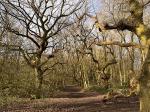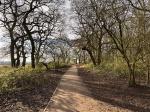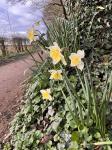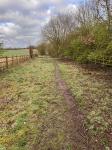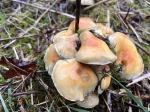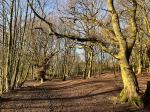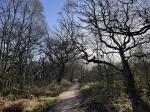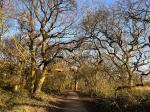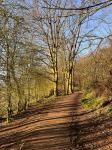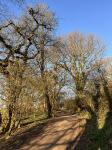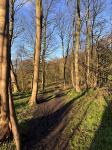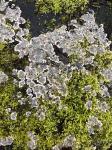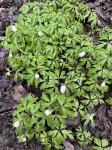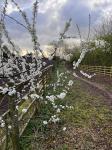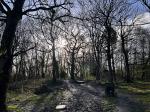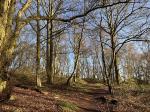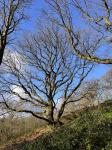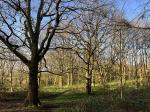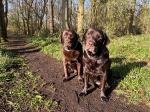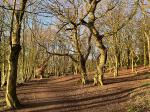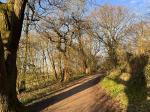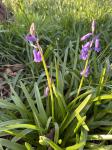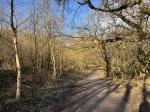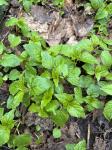Brayton Barff Through the Seasons.
Set in the Vale of York, South West of the market town of Selby and between the villages of Thorpe Willoughby and Brayton, lies Brayton Barff, a sandstone Hill approximately one hundred and fifty feet in height which was formed by glacial movement during the last Ice Age. It is a significant landmark in an otherwise flat landscape.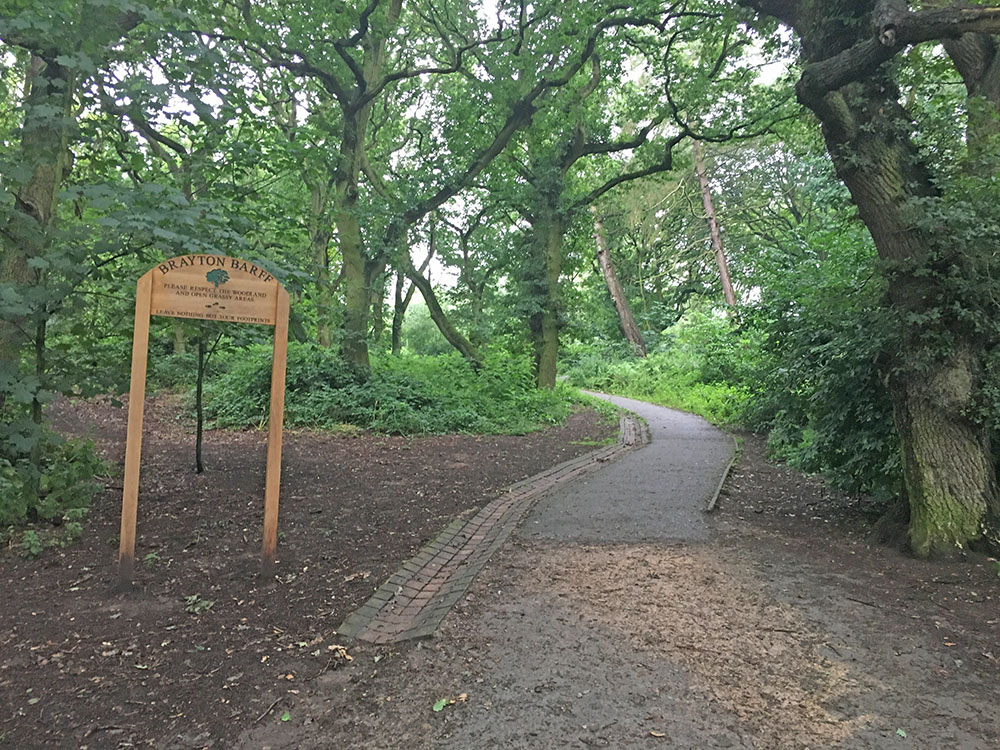
Today the site is primarily owned by Yorkshire Water with Selby District Council owning a small patch of the land adjacent to the A63 Selby bypass. A large underground reservoir occupies the centre of the site which delivers water to around 4.7 million customers throughout Yorkshire.
Within the Barff woodland over 40% of the trees are Sessile Oak which are generally found in semi natural woodlands in the north of the country. These trees are so called because its acorns are not held on stalks, like those of the English Oak (Pedunculate), but attached directly to the outer twigs. There are also several English Oak trees as well as some cross-hybrid oaks. These trees are known to support many species of flora and fauna, invertebrates, mosses, lichen and fungi.
During the Victorian times it is thought that the shipbuilders on the east coast would come over to the Barff for selected cuts of timber to build their sea going vessels.
The Barff also has a variety of other trees including Silver Birch, Beech, Sycamore, Holly, Rowan, Scots Pine, Alder, Hawthorne and European Larch. There are also several Yew, Willow, Hazel, Horse Chestnut and Wych Elm. As with similar woodlands there are a variety of bushes, including Honeysuckle, Elderberry, Gorse, Broom and Buddleia.
The history of Brayton Barff is quite vague, apparently during 1803 a beacon was lit on the Barff when the country was threatened with an invasion by Napoleon. In May 1935, to celebrate King George V's Silver Jubilee, a Bonfire was lit on the Barff as part of the celebrations.
Early issues of Ordnance Survey Maps dated 1903 clearly show a rifle range on the Barff, extending out to Mill Lane. During the 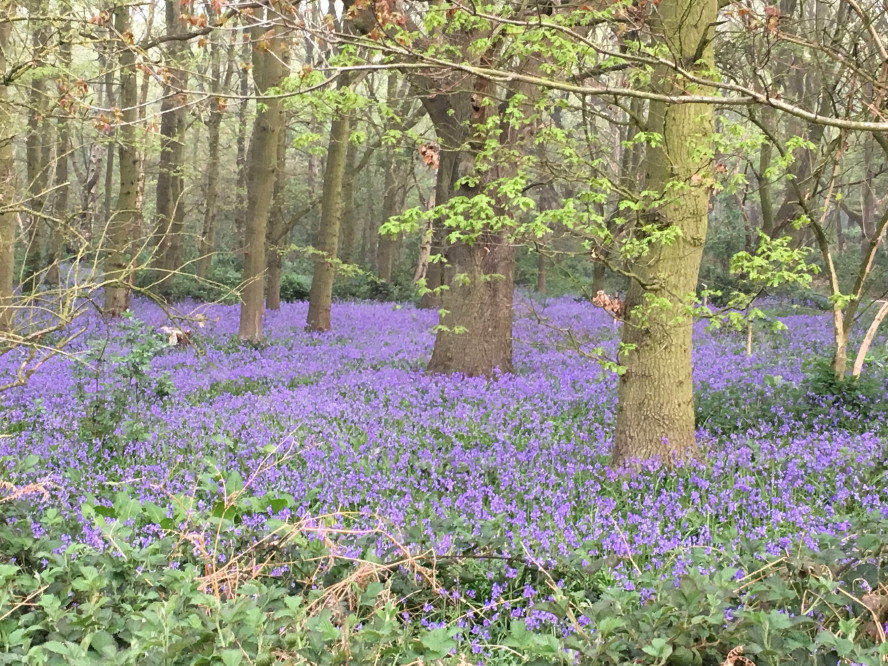
Between 2001 – 2004 the A63 Selby bypass, 10km twin lane single carriageway was constructed which severed the South West corner of the Barff, adjacent to Selby Golf Course and resulted in a slight redesign of several holes on the golf course. Wooden fencing was erected as a result of this new road running alongside of the Barff and a footbridge constructed over the ‘new road’ following the line of the Bridal way which extends from Mill Lane. Around 2005/2006 a definite 2metre wide limestone aggregate footpath was laid forming a circular path around the outer edges of the woodland. This footpath is approximately 1.2 miles in length and takes about 30 minutes to circumnavigate at a leisurely pace.
In 2012 the Barff was declared an Ancient Oak Woodland and as such throughout 2012 and 2013 significant work had been carried out by the relevant agencies to cut and remove large swathes of non-native trees, creating at that time huge scars on the landscape. Some three years later the planting of the native trees have become well established and are flourishing. Ongoing maintenance work on the footpath around the bottom of the Barff was completed during the Summer of 2016.
A second phase of woodland maintenance commenced during the Autumn of 2019 with the removal of many old and diseased trees and the cutting back of the Gorse and Broom bushes, especially adjacent to the ‘bypass trail’, this work continued through till March 2020 with re planting continuing into April 2020.
Brayton Barff is a popular site for walkers and bird watchers alike and a path circling the outer perimeter of the Barff makes a pleasant thirty minute walk, giving views looking over towards Selby and the village of Brayton as well as the power stations of Drax and Eggborough..jpg)
For the early risers it is a great place to see some stunning sunrises over the villages of Brayton looking towards Drax Power Station, the same with the Sunsets looking over towards Eggborough and Monk Fryston.
The Barff changes with the Seasons and every visit can reveal something new, the woodland is a haven for wildlife. Records show that since 1982 one hundred and twelve species of bird have been seen in the woodland and at least 40 of those have bred here, including Tawny Owl, Buzzard, Green Woodpecker, Spotted Flycatcher, Goldcrest and Nuthatch to name just a few. On average over 70 species of bird are recorded each year. Further details of the bird life on the Barff can be found on the Brayton Barff Group Facebook page, especially the posts from Derek Cooper. Today ‘The Friends of Brayton Barff group’ led by Derek and a small team of volunteers help keep and maintain the cleanliness of the site as well as recording the wildlife and bird sightings.
The Barff is also home to fifteen different species of mammals, including Muntjac Deer, Pipistrelle Bat, Fox, and Field Vole.
Over eighty species of plant and wildflowers have been recorded, included Bee Orchid, Northern Marsh Orchid, Wood Anemone, Marsh Ragwort, Bluebell, White Bluebell, Bittersweet and Purple and White Foxgloves. Over twenty species of Butterfly have been recorded, including Marbled White, Brown Angus, Speckled Wood, Comma and Brimstone.
During the Autumnal months fungi thrives in this woodland environment, species including Fly Agaric, Beefsteak Tree Fungi, Chicken of the Wood, Sulphur Tufts, Stinkhorn, Ink cap, Puffballs and Hoof Bracket are just some of the many varieties that can be found here.
Click on the galleries shown below to expand the albums.
March 2024
These monthly updates from my daily walks around the Barff seem to come round much to quick these days. Although it has been another wet month, it has been much warmer than normal. The Daffodils have flowered a fortnight earlier than last year and the Bluebells have started to flower towards the end of the month, very similar to last year. It has been good to see the Blackthorn bushes in full flower, along with the yellow florets of the Gorse bushes which brings some early colour to the woodland.
Friday 1st March, and the start of the month. It was a cold, bright and sunny morning, 3C with a light westerly breeze. One of those days when you could have stayed out and walked for miles.
Saturday 2nd March. What a contrast to yesterday, this morning was a dull, wet, and drizzly morning, very muddy and slippery on the top of the Barff. It was nice to hear the blackbirds singing this morning, they usually seem too busy scratting through the leaf litter. The Greater Spotted Woodpeckers were very vocal this morning, one in particular has been busily drumming away (for several mornings) on a tree adjacent to the old farm shop close to the works entrance to the woodland.
Sunday 3rd March, was another cold but dry morning, 3c no wind, bright, misty sunny, v wet and muddy underfoot from all the rain we have had lately.
Monday 4th March, a cooler morning today at just 0c, foggy and an overnight frost. The Car park was closed this morning to allow the subcontractors to resurface the entrance and clean up the car park. Consequently, it was very quiet on the Barff this morning. Chaffinch and Robins seem to follow me around the woodland today, popping up on a branch in front of me just as I walk past it. A Song Thrush was singing its heart out adjacent to the bypass trail.
Tuesday 5th March, the car park was still closed this morning. At least it was a little warmer at 5c, but it was a dull, cloudy, and overcast start to the day.
Wednesday 6th March, 3c, and a cold, dull and damp morning. The car park entrance has now been resurfaced, and the car park cleaned up and white lines refreshed. The Car park was back open this morning. I watched a Nuthatch for several minutes, busily taking nesting material into its bird box, one they have nested in now for several years. I am certain I heard a Chiffchaff this morning too, I will have to listen more intently on my next visit.
Thursday 7th March, was another dull, cloudy, and overcast morning, just 3c, and a tad chilly on the finger ends.
Friday 8th March, yet another cold, dull, and overcast morning, it felt much colder than 5c due to the light northerly breeze. The weather did not seem to put of the Grey Squirrels though as they busily played tig with their siblings, scurrying up and down the tree trunks and running at breakneck speed along the branches without a fear in the world, completely unaware of their height above ground should they miss their footing.
Saturday 9th March. A chilly, cold easterly wind this morning. Dull, cloudy, and overcast 5c a miserable start to the day.
Sunday 10th March. It was a wet and rainy walk this morning, 7c. The heavy overnight rain continued throughout the day, leaving lots of puddles.
Monday 11th March, another dull, damp, and miserable morning, very muddy underfoot. As I left the top of the Barff and followed the muddy trail down the slope towards the old pump house, I passed a singing Song Thrush which brightened up my morning, it was perched on top of one of the bramble briars, contently singing its rhythmic melody just like a young chorist at a Sunday evenings church service, it had quite a selection of tunes in its repertoire which was lovely to hear and took my mind of this miserable damp wet weather.
Tuesday 12th March. 5c, another dull, damp, wet, and rainy walk this morning. I’m beginning to get a little fed up with the monotony of the weather of late. The wet and humid weather is suiting the flora on the Barff though, young nettles seem to be shooting up, the leaves of the Bluebell appear to have grown a couple of inches overnight! along with Bramble briars and Creeping Buttercup which is creeping at an alarming rate too. The fern like leaves of Cow Parsley are growing apace although it will be a couple of months before it comes into flower, and Lesser Celandine, a native plant to this country, is growing and spreading nicely on the woodland floor, it is one of the first flowers to appear after winter. They provide an important nectar source for queen bumblebees and other pollinators emerging from hibernation, as well as other early insects, they should be coming into flower within the next few weeks.
Wednesday 13th March, a very mild morning 12c at 7.30am! with a light westerly breeze, bright and sunny and a very pleasant walk through the woodland, a lighter jacket required for tomorrows walk.
Thursday 14th March, a mild, dry, and bright morning, 11c, I had my lighter jacket on this morning instead of my heavier winter jacket. It was very muddy underfoot especially around the top of the Barff. The Grey Squirrels were very lively this morning, Dunnocks and Wrens provided a pleasant selection of tunes as I walked off the top of the Barff. It was good to hear two drumming Greater Spotted Woodpeckers. Song Thrush was very vocal too, often accompanying the Dunnocks and Wrens. Blue Tits, Great Tits and another Song Thrush were very vocal along part of the Bypass trail.
It is nice to see several clumps of Daffodils in full flower in the woodland, be it on the perimeter footpath and on the top of Tap Hill, these are at least a fortnight earlier flowering than last year.
I heard the Chiffchaff this morning on the Barff summit.
Friday 15th March, well, here we are, halfway through the month already. Today was another mild, 11c, dull and overcast morning, the overnight rain kept the paths wet and muddy and very slippery in places. What a welcome I received on the Barff this morning with a beautiful dawn chorus, Dunnock, Wren, Robin, Chiffchaff, Chaffinch accompanied by a Song Thrush with occasional performances from the Greater Spotted Woodpecker and Buzzard a wonderful treat to the ears.
Saturday 16th March, what a difference a day makes, a slight overnight frost, 0c at 7.00am, lovely clear blue sky and sunshine, we could have stayed in the woodland all day today, listening to birdsong and signs of wildlife.
Sunday 17th March, a very wet rainy morning, 12c, v muddy underfoot.
Monday 18th March, what a beautiful morning, bright, and sunny, with no wind, 13c and very mild and humid, though it was extremely wet underfoot. My first sighting of the Himalayan Balsam showing through the leaf litter on the woodland floor.
Tuesday 19th March, was another beautiful early morning walk, 11c at 7.00am, bright clear blue sky, sun shining, very pleasant walk. Everything is greening up nicely, Blackthorn is in flower, Hawthorn bushes are greening up nicely, all the trees are in bud, Elderberry bushes are sprouting their leaves, clumps of Nettles are popping up all over the place, and Foxgloves are beginning to grow, at this rate the Bluebells will be starting to flower next week. The Gorse bushes are still a mass of yellow florets. It is still very muddy and slippery on the top of the Barff.
Lots of birdsong in the woodland this morning, the star of the show being the Chiffchaff, they out sang the Wrens and Robins today with their strong repetitive vocal piece. Robins and Blue Tits tended to follow me on today’s walk, always popping up on a small branch in front of me singing their heads off. Blackbirds were busily going about their business on the woodland floor. A greater Spotted Woodpecker was busily drumming away alongside the main road close to the service road entrance to the woodland.
No sooner had I returned home, and whilst grooming the dogs before breakfast, the heavens opened, and we had a good thirty-minute downpour! Pleased we weren’t caught in that.
Wednesday 20th March, after very heavy overnight rain it was another wet and drizzly walk this morning, very slippery underfoot. It was quite humid again at 10c with no breeze to mention. Everything is greening up at an alarming rate, Spring is certainly in the air. Bird song was beautiful to listen to today, I stopped in a couple of places just to listen to it, the first at the small bench near to the old pump house, we had the full choir out today, being led by the Chiffchaff, Wood Pidgeon, and Wren, with accompaniment from the Song Thrush, Crow, Dunnock and Nuthatch, the Greater Spotted Woodpecker made a cameo appearance but soon got distracted by a Crow which came a little too close for comfort. It was nice to see a pair of Greylag geese fly over, they circled above me before coming round again before flying off towards Fairburn Ings. Wild Garlic continues to spread over the woodland floor and Wood Anemone are just coming into flower.
Thursday 21st March, a dull and overcast morning very muddy underfoot, a watery sun trying to break through. Lots of birdsong around the woodland.
Friday, 22nd March, a Cloudy and dry morning, 9c with a chilly NW wind.
Saturday 23rd March, a cold morning, 4c, heavy rain showers and intermittent sunshine, nice and bright in the sunshine. Spotted my first Bluebell in flower this morning.
Sunday 24th March. A beautiful cold morning, just 4c, with a cold north westerly wind. The muddy patches around the Barff look to be finally drying up. The Wood Anemone are beginning to come into flower, as were more Bluebells. There was lots of birdsong this morning, including Chiffchaff, Robin, Dunnock, Wren and Wood Pidgeon.
Monday 25th March was another cool morning, just 4c at 7.15 am. by the time we reached the Barff. It was a dull and cloudy start to the day; rain was forecast for later in the morning but for now it was nice and dry. It looks as though the Maize field which has been fallow for several months since it was harvested is starting to be reworked, the farmer having ploughed around the outer boundary of the field. Birdsong was very vocal this morning, being led by the Chiffchaff, in fact they were appearing all over the woodland this morning, accompanied by the Song Thrush, Wren, Robin, Coal Tit and Blue Tit with occasional appearances by the Wood pigeon.
I spotted a nice clump of ‘Summer Snowflake’ (like Snowdrops but much taller) in full flower on top of the Barff this morning, I have not noticed them up here before, and may have been planted by another visitor to the woodland, they usually flower several weeks after the Snowdrops have finished flowering, Leucojum aestivum their Latin name, is a native English flower which dates to 1594. It is much prized in England and Europe because it is deer and rodent resistant and moisture tolerant. It also is known to flourish in dappled sunlight, so should thrive on the Barff. They grow to a height of between 12 – 15 inches and can produce between 5-6 white bell-shaped florets on each stem, the green foliage is just like long blades of grass.
Tuesday 26th March, another cold, 5c, dull and cloudy morning at 6.30am, a watery sun was trying to break through the cloudy sky but did not make it till mid-morning. The persistent rain we had yesterday afternoon and overnight made the tracks around the woodland very slippery and muddy again this morning. There was lots of birdsong though to lift the spirits, the chief chorists being the Chiffchaff and Song Thrush, accompanied this morning with the Robin, Coal Tit, Blue Tit and Wren, it is such a lovely sound. As we passed by the old pumping station, I heard a flock of Geese fly overhead but due to the tree cover and low cloud I could not make eye contact them. Bluebells are continuing to flower in selected areas, especially the ones which get the benefit from the early rising sunlight. It will be several weeks before we get the heady Bluebell scent drifting through the still morning air. Nettles, Bramble, Foxglove and Honeysuckle are shooting up at an alarming rate.
As the Easter holidays approach, we are all heading off to Kent for a long weekend. It will be interesting to see how much the woodland has changed when we return next week, let’s hope it starts to dry a bit. Happy Easter.
|

